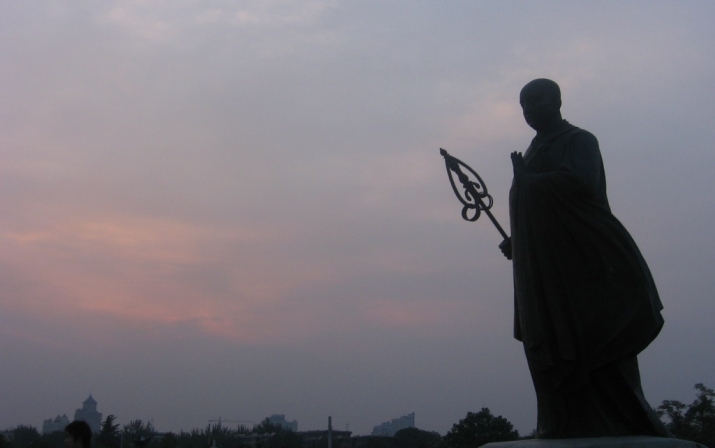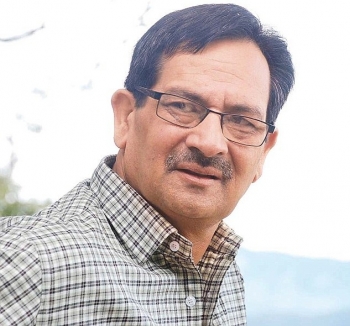While Tewari told The Economic Times that the sojourn would focus on the “spirit of Buddhism,” he was tight-lipped about the specifics: “While you have heard they [sic] names of Hieun Tsang and Fa Hien, there were many others who were instrumental in the spread of Buddhism. The project does not involve any excavation, but I am not in position to share any details.” (The Economic Times)
The trip involves some of the highest-ranking echelons within the Indian government: Tewari’s plan was approved by Dr. Mahesh Sharma, the minister of culture, and the prime minister’s office has also given permission. The Ministry of Culture has written to the Ministry of External Affairs for faster clearance as it involves entry into China. In the project proposal, Tewari claimed that it would help “in creating political stability, friendly cultural atmosphere, and also in boosting economic development of the region.” (The Economic Times)
NEWS
Archaeological Survey of India to Retrace the Footsteps of Chinese Buddhist Missionaries
 Statue of Xuanzang at the Great Wild Goose Pagoda in Xi'an. From wikipedia.org
Statue of Xuanzang at the Great Wild Goose Pagoda in Xi'an. From wikipedia.orgThe director general of the Archaeological Survey of India (ASI), Dr. Rakesh Tewari, is planning to research and “retrace the footsteps of ancient travellers Fa-Hien [Faxian] and Hiuen Tsang [Xuanzang],” about 1,500 years after they undertook their incredible journeys on foot from China to India.
The proposed project’s name, “Kashi to Kashgar,” refers to a nearly 2,600km journey from Varanasi (also known as Kashi) in Uttar Pradesh, India, to Kashgar, an oasis city in China's Xinjiang Autonomous Region. Located near the Chinese border with Afghanistan, Kyrgyzstan, Pakistan, and Tajikistan, Kashgar has a rich history of more than 2,000 years and served as a trading hub on the Silk Road between China, the Middle East, and Europe.
Xuanzang (602–64) passed through Kashgar on his return journey from India to China, returning to the Tang dynasty (618–907) capital of Chang’an in 645. His predecessor Faxian (337–422) crossed the freezing deserts and perilous mountain passes from China into northwest India during the reign of Chandragupta II (r. 380–415). He did not, however, pass through Kashgar on his way home, as he visited modern-day Sri Lanka and was shipwrecked on an island (possibly Java) before returning to the coastal province of Shandong in eastern China. Both monks published important travelogues of their pilgrimages.
According to sources cited by India Today, Tewari will embark on a three-month road trip to China to retrace the specific portion of the land route between Varanasi and Kashgar. However, the details of the trip are unclear. An anonymous source, described as a renowned historian, told India Today: “It’s strange the head of India’s premier conservation agency, who should be looking after administrative work, will be out on such a long journey.”
 Dr. Rakesh Tewari, director general of the Archaeological Survey of India. From dailymail.co.uk
Dr. Rakesh Tewari, director general of the Archaeological Survey of India. From dailymail.co.ukA financial plan for the project is being worked out, with a projected price tag of US$747,842, which includes the urchase of an SUV to traverse the harsh sandscapes of China’s deserts. A team of assistant archaeologists, photographers, surveyors, and logistical staff will follow Tewari in another vehicle.
Tewari first prepared the proposal in 2006, when he was director of the Uttar Pradesh Archaeological Department. Due to retire in May 2017, Tewari wants to accomplish his dream project as early as possible.
See more
Rediscovering missionary route: ASI chief’s file on Kashi-Kashgar trip reaches FS (The Economic Times)
ASI’s director to retrace steps of ancient travellers to India, will go on 3-month ‘road trip’ to China (India Today)
ASI chief will ‘retrace the footsteps’ of ancient travellers Fa-Hien and Hiuen Tsang in a 2,600km trip across China (Mail Online India)














